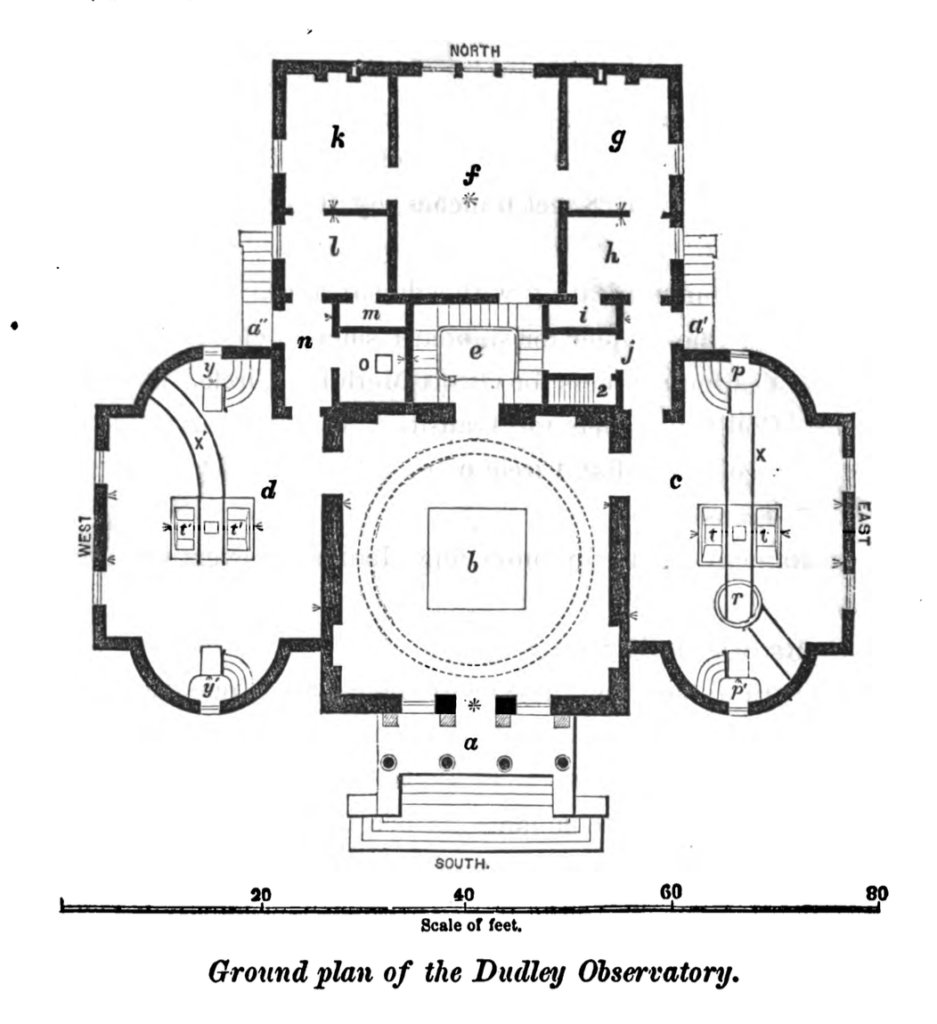
The Annals of the Dudley Observatory, Vol. I, published by Weed, Parsons in 1866, provides a handy ground plan of Blandina Dudley’s dream observatory, which was formally inaugurated in 1856. The space marked a was the front entrance and piazza. Immediately inside, b, was the base of the equatorial pier, essentially the permanent mounting point for a telescope..
To the east, c, was the Olcott Meridian Circle, in a room 22 feet 9 inches by 35 feet 7 inches. The transit piers are marked as t; r is the turntable for turning the apparatus, and x is the track. p are the collimator piers for the meridian circle. So, what’s a meridian circle? Wikipedia is glad you asked.
The meridian circle is an instrument for timing of the passage of stars across the local meridian, an event known as a transit, while at the same time measuring their angular distance from the nadir. These are special purpose telescopes mounted so as to allow pointing only in the meridian, the great circle through the north point of the horizon, the zenith, the south point of the horizon, and the nadir. Meridian telescopes rely on the rotation of the Earth to bring objects into their field of view and are mounted on a fixed, horizontal, east-west axis.
To the west of the equatorial pier, d was the Transit Room, 22 feet 7 inches by 35 feet 4 inches. This would have held a transit telescope, which would not have been on an east-west fixed axis. Here you can see that the track x curves. Y are the collimator piers for the transit.
Directly behind the equatorial pier is the Hall, e, which led to the Library (f – with cases for books on the east and west sides) and stairs leading to the dome. g and k were the computing rooms, h the chronograph room, and l the sleeping room.
Directly opposite to the front entrance, is a niche cut in the base of the Equatorial pier, in which is placed a bust in marble, executed by Palmer, of the Hon. Charles E. Dudley. On the right of the entrance is a marble dial of the magnetic mean-time clock, the pendulum of which occupies the left of the entrance. Near the middle of the east and west sides of the hall, are portraits in oil and marble slabs, commemorative of the former director, Prof. O.M. Mitchel, and the assistant astronomer, Mr. August Sontag. On the north wall are marble slabs on which are inscribed the names of the Donors . . .
The distance between the floor and ceiling is the same for all the rooms, and is 14 feet 6 inches.
There is a cellar underneath the whole building. This is used for the furnace, batteries, work shop and other purposes. The furnace is placed directly under the room l. Only the north part of the building is heated, including the library and rooms adjoining. As the meridian rooms are separated from the heated portion, by the side entrance halls, no heat can pass into them.
The walls for supporting the revolving dome are built of brick, two feet thick. The height of the cap-stone, on which the equatorial pier rests, is 18 feet 7 in. above the floor of the meridian rooms. The equatorial room is reached by a winding stairway, shown in the ground plan at e.
The dome is a cylinder of 15 ft. in height, and 22 ft. inside diameter, framed of scantling, and covered on the inside and outside with three-quarter inch pine. It rests on a cylindrical foundation of wood, at a distance of 7 ft. above the base of the pier. On the top of this foundation is a bed-plate of cast iron, 9 inches in width, hollowed in the middle; a similar bed-plate is bolted to the under section of the dome; and between them are placed 15 cast-iron balls, 7 inches in diameter, upon which the dome revolves. Soon after the completion of the dome, it was found that the balls were liable to become unequally distributed. In order to prevent this, they were provided with axes, and mounted in a wrought-iron frame. When the dome revolves, this frame is carried around with the balls.
The Annals contain substantially more detail on the construction of the building and detailed drawings of the equipment therein, including the Olcott Meridian Circle.
As noted in the comments below, the Palmer bust of Dudley, as well as the marble donor slabs and the Olcott Meridian, are still in possession of the Dudley Observatory, in the MiSci in Schenectady. The bust is on display outside the planetarium.

Leave a Reply